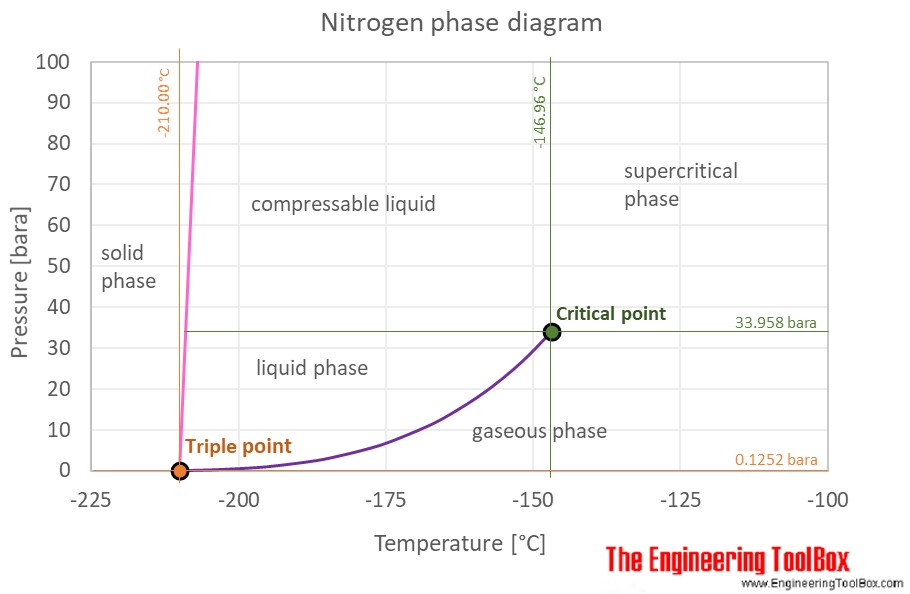Nitrogen - Thermophysical Properties (original) (raw)
Nitrogen, N2, is at standard conditions a colorless odorless gas. The gas makes up the major portion of the atmosphere, but will not support life by itself. Refrigerated (cryogenic) nitrogen, is a colorless odorless liquid.
Gaseous nitrogen is used in food processing, in purging air conditioning and refrigeration systems, and in pressurizing aircraft tires. Liquid nitrogen is used to freeze foods, to preserve whole blood and other biologicals, and as a coolant.
Nitrogen is nontoxic and noncombustible, but it may cause asphyxiation by displacement of air. Liquid nitrogen is very cold and and contact may cause frostbite. Under prolonged exposure to fire or heat, nitrogen containers may rupture violently and rocket.
The phase diagram of nitrogen is shown below the table.
Chemical, physical and thermal properties of Nitrogen:
Values at 25 oC (77 oF, 298 K) and atmospheric pressure
Nitrogen - Thermophysical Properties
| Molecular Weight | 28.013 |
|---|---|
| Specific Gravity, air = 1 | 0.967 |
| Specific Volume (ft3/lb, m3/kg) | 13.98, 0.872 |
| Density of liquid at atmospheric pressure (lb/ft3, kg/m3) | 50.46, 808.4 |
| Absolute Viscosity (lbm/ft s, centipoises) | 12.1×10-6, 0.018 |
| Sound velocity in gas (m/s) | 353 |
| Specific Heat - cp - (Btu/lb oF or cal/g oC, J/kgK) | 0.249, 1040 |
| Specific Heat Ratio - cp/cv | 1.40 |
| Gas constant - R - (ft lb/lb oR, J/kg oC) | 55.2, 297 |
| Thermal Conductivity (Btu/hr ft oF, W/moC) | 0.015, 0.026 |
| Boiling Point - at saturation pressure 14.7 psia and 760 mm Hg - (oF, oC) | -320.4, -195.8 |
| Latent Heat of Evaporation at boiling point (Btu/lb, J/kg) | 85.5, 199000 |
| Freezing or Melting Point at 1 atm (oF, oC) | -346, -210 |
| Latent Heat of Fusion (Btu/lb, J/kg) | 11.1, 25800 |
| Critical Temperature (oF, oC) | -232.6, -147 |
| Critical Pressure (psia, MN/m2) | 493, 3.40 |
| Critical Volume (ft3/lb, m3/kg) | 0.051, 0.00318 |
| Flammable | no |
Follow the links below to get values for the listed properties of nitrogen at varying pressure and temperature :
- Density and specific weight
- Dynamic and kinematic viscosity
- Prandtl number
- Specific heat (heat capacity)
- Thermal conductivity
- Thermal diffusivity
See also more about atmospheric pressure, and STP - Standard Temperature and Pressure & NTP - Normal Temperature and Pressure,
as well as Thermophysical properties of: Acetone, Acetylene, Air, Ammonia, Argon, Benzene, Butane, Carbon dioxide, Carbon monoxide, Ethane, Ethanol, Ethylene, Helium, Hydrogen, Hydrogen sulfide, Methane, Methanol, Oxygen, Pentane, Propane, Toluene, Water and Heavy water, D2O.
Nitrogen is a gas at standard conditions. However, at low temperature and/or high pressures the gas becomes a liquid or a solid.
The nitrogen phase diagram shows the phase behavior with changes in temperature and pressure. The curve between the critical point and the triple point shows the nitrogen boiling point with changes in pressure. It also shows the saturation pressure with changes in temperature.

At the critical point there is no change of state when pressure is increased or if heat is added.
The triple point of a substance is the temperature and pressure at which the three phases (gas, liquid, and solid) of that substance coexist in thermodynamic equilibrium.
Related Documents
Acetone - Thermophysical Properties
Chemical, physical and thermal properties of acetone, also called 2-propanone, dimethyl ketone and pyroacetic acid. Phase diagram included.
Solubility of Gases in Water vs. Temperature
Solubility of Ammonia, Argon, Carbon Dioxide, Carbon Monoxide, Chlorine, Ethane, Ethylene, Helium, Hydrogen, Hydrogen Sulfide, Methane, Nitrogen, Oxygen and Sulfur Dioxide in water.